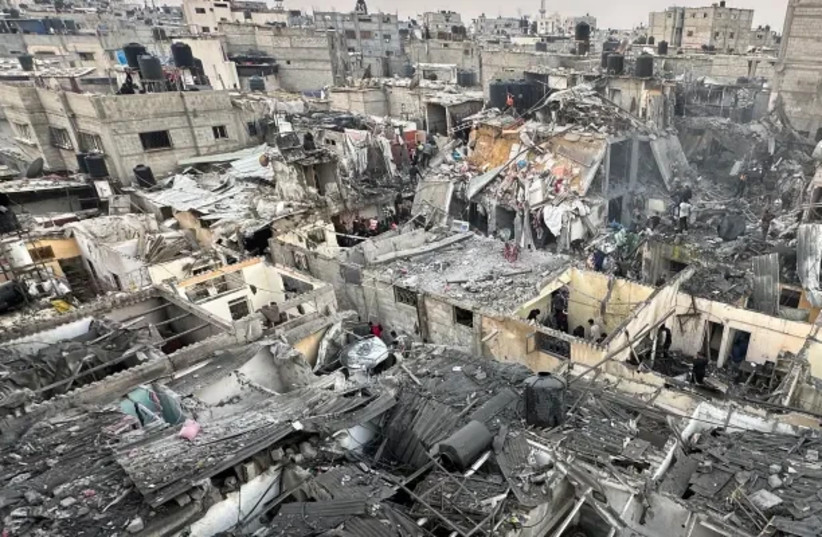Hamas has been regularly accused of manipulating the death count in Gaza throughout the war, but with independent verification being nearly impossible, such accusations have been hard to prove.
The Washington Institute for Near East Policy released a report at the end of January that attempted to show the discrepancies in the official fatality report's figures, and that such discrepancies were most likely caused by manipulations.
The report begins by stating that Hamas's figures have been previously quite similar to both the UN's official figures and Israel's figures, which is why they have been given so much credence by international organizations, however reporting since the start of the ground invasion on October 27 has become less rigorous and less reliable.
President Biden questioned the figures released before the ground invasion, saying he doesn't doubt that innocents have been killed but that he has "no confidence in the number that the Palestinians are using."
Reports before the ground invasion seem to have been accurate, with all but 281 fatalities having identification numbers, genders, and ages.
The Hamas-run Gaza Health Ministry stopped reporting fatalities on November 10, resuming its reports on December 2, although with significantly less detail.

The report suggests that reports for all fatalities after November 10 lack credibility due to their reliance on "reliable media sources," which the report says are largely composed of news clips found online or on TV. UN reports have not mentioned that they rely on such media reports for their data.
The report warns, "Here a cautionary note is necessary: even as most combatants are men, most Gazan men are still civilians, rendering the overall number of men killed an imperfect proxy for Hamas fighters."
Citing discrepancies in reporting on the deaths from the al-Ahli Hospital blast, when Israel was falsely accused of attacking the hospital, as well as general inconsistencies, the report finds that the number of male fatalities has been manipulated, towards underreporting.
For example, during the al-Ahli hospital blast in which Hamas claims 471 were killed, Hamas figures show only 7 other people were killed throughout Gaza during the same 24-hour period as the blast (478). This is completely inconsistent with figures released by the UN saying 62 were killed in two airstrikes the same night in the Jabalia refugee camp, which should make the total 533 not the 478 published by Hamas.
In another event, the numbers released in the same report were completely inconsistent with each other, with summaries on one page saying 7,028 had been killed, while a few pages later the totals on the graphs added up to different figures with none equaling 7,028.
Following the ground invasion discrepancies increased
Following the invasion on October 27, the report says discrepancies became more common.
On October 29, two days into the invasion, the Health Ministry released figures that showed an unexplained decrease in the total number of male fatalities of 72 from 2,231 to 2,159. On November 5, there was another revision down of 274 from 2,890 to 2,616.
The rate of fatalities across genders also altered dramatically following the invasion, before October 27 male fatalities were about 34%, while females were at 25% and children at 41%, while afterward, males comprised around 25%, females 33%, and children 42%.
"The Health Ministry figures released since November 11 should be viewed with extra skepticism given the ministry’s acknowledgment that the figures for northern Gaza come from “reliable media sources,” which are unverified and extremely unlikely to include militant deaths."
As the war progressed large discrepancies began to appear between the Hamas-run Health Ministry and the Hamas-run Government Media Office (GMO), with a report from the Health Ministry claiming 5,577 adult men had been killed and a GMO report which showed 4,212 men killed at most.
From December 2 to December 8 the GMO reduced the total male fatalities by over 1000 (from 4,563 to 3,499).
By January 1 the Health Ministry was reporting that before November 11, 6,088 men had died in Gaza, the GMO reported on the same day that a total of 6,098 men had been killed by January 1, implying only 10 men had died across 51 days of fighting from November 11 until January 1.
The report also challenges the validity of the figures themselves saying that 61% of the fatality reports after November 10 come from media reports which are highly susceptible to manipulation.
When compared to IDF figures, which claim 9,000 fighters killed in Gaza, the discrepancy becomes that much larger. The report says to treat IDF numbers with some skepticism, however, even then the 6,088 male fatalities claimed by Hamas, which will include civilians, fall far short of Israeli estimates of just the militants killed.
However, it is important to remember that producing accurate up-to-date fatalities during a war is very difficult and revisions are to be expected, as occurred when Israel revised down the total killed on October 7. The report even cites this as an example of why accurate reporting of fatalities often takes significant time.
The report concludes that the motives for reducing the number of male fatalities are clear.
"What can be said for certain is that Hamas-produced statistics are inconsistent, imprecise, and appear to have been systematically manipulated to downplay the number of militants killed and to exaggerate the proportion of noncombatants confirmed as dead," the report concludes.
